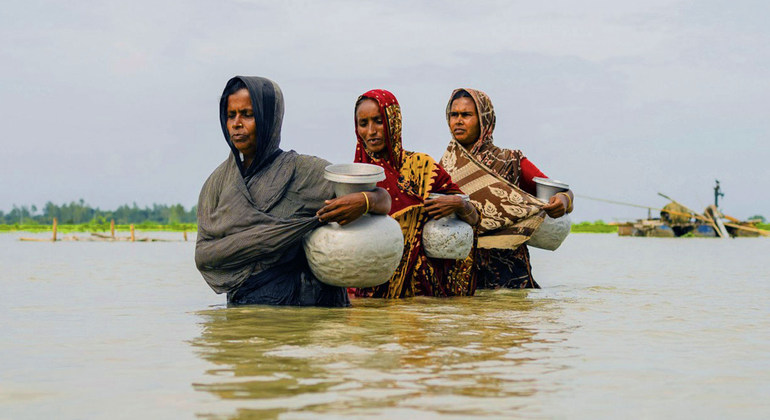“Humanitarian workers are here to help the world’s most vulnerable people when disaster strikes”, the Secretary-General said.
“But around the world, aid workers face growing threats. In the past 20 years, shootings, kidnappings, and other attacks on humanitarian organizations have increased tenfold. This year alone, at least 72 humanitarian workers have been killed in conflict zones.”
#TheHumanRace
This year’s campaign for World Humanitarian Day – #TheHumanRace – underscores how climate extremes are wreeaking havoc across the world and overwhelming frontline responders.
Mr. Guterres warned that the climate emergency “is a race we are losing. But it’s a race we can and must win.”
Hosted on exercise platform Strava, participants are asked to clock 100 minutes of exercise for the World Humanitarian Day campaign.
“They can run, roll, ride, walk, swim, kick or hit a ball, each action will count towards helping us carry our message to world leaders when they meet at the UN Climate Change Conference (COP26) in November,” said UN humanitarian coordinating office, OCHA, which organized the campaign.
Honouring the fallen
The UN system across the world commemorated the day solemnly and words of support for the families of aid workers injured or killed while helping others.
In Switzerland, UN Geneva Director-General Tatiana Valovaya and UN High Commissioner for Human Rights Michelle Bachelet laid a wreath in memory of the fallen, against the backdrop a UN flag all-but-obliterated by the 2003 suicide bombing of the Canal Hotel in Baghdad, where 22 UN staff lost their lives.
Noting with concern the fast-evolving situation in Afghanistan where more than 18 million people need emergency assistance, Ms. Valovaya insisted that aid workers would “remain faithful to their mission of providing vital services to affected communities”.
Ms. Bachelet paid tribute to the “courage and commitment” of all those who had been killed in the service of human right, saying “our work breaks down hatred and violence. We are creating better, more resourceful societies – where fewer tragedies occur – but when they do, we equip people to surmount them.”
Extreme weather risks
Insisting that climate change is the “defining issue of our times”, the UN migration agency (IOM) pointed to the global experience of extreme temperatures, rising sea levels, drought and storms.
For World Humanitarian Day 2021, IOM Director-General Antonio Vitorino urged the international community to focus on the vulnerable populations worst-hit by climate change – and the many “climate migrants” that will likely be forced away from their communities.
“Last year, more than half of all new displacements worldwide were due to weather-related disasters”, Mr. Vitorino said. “Millions lost their homes, access to food and water and their entire livelihoods due to worsening and more frequent climate hazards”.
With additional pressures on humanitarian aid delivery created by the COVID-19 pandemic, the IOM chief underscored how frontline workers were stretched even further than before.
“The climate emergency is a race against time”, he said, urging Governments, the private sector and concerned citizens to help scale up emergency preparedness and resilience building, along with climate change adaptation and mitigation.
Syrian woes continue
In Syria, where conflict recently flared in the southwest, UN agencies paid tribute to humanitarians under ever increasing pressure there.
“We continue to see crisis upon crisis in Syria, with ongoing hostilities, economic deterioration and growing inequalities, and an unrelenting pandemic,” warned the UN Children’s Fund (UNICEF), UN Development Programme (UNDP), World Food Programme (WFP), Population Fund (UNFPA), Office of the High Commissioner for Refugees (UNHCR), IOM and the UN Regional Humanitarian Coordinator for the Syria Crisis (OCHA).
Pointing to the growing impacts of climate change in Syria and the “ever more severe droughts, forest fires and floods”, the agencies emphasized that it was the most vulnerable – and particularly women – who suffered most from its consequences.
“This can be seen in the lack of water, food, electricity and livelihoods opportunities for millions and the resurgence of diseases, due to the ongoing drought”, they said.



